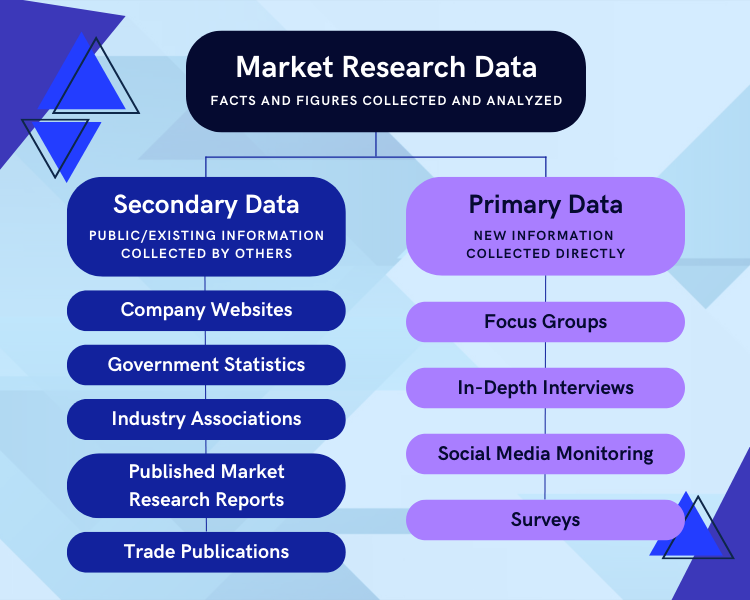 The sources of data that we use to make key decisions are more important than ever.
The sources of data that we use to make key decisions are more important than ever.
Not only can you simply plug your search term into any web browser, but you will also get an almost innumerable number of results, many of which circularly source from one another. As such, how can you avoid bad data and ensure that you’re relying on the best information to make strategic decisions?
The experts here at Freedonia Custom Research (FCR) are here to help you navigate all of these data sources.
At the highest level, market research data can be split into primary and secondary data sources, although from a best practices perspective, secondary research should always be performed first.

What Is Secondary Data?
Secondary data is publicly available or relatively inexpensive to obtain and can be used as the foundation for any analysis or business decision — so long as you can feel comfortable regarding the source, something FCR can assist with.
Secondary Data Examples
Sources of secondary data include, but are not limited to, the following:
Company Websites
- Advantages — Public companies tend to have investor relations sections on their websites that are full of reports and other investor documents that can provide insights on both the company, as well as the industry overall.
- Disadvantages — Private companies are not required to report sales or other types of financial information, while public companies only have to report certain information, so if you are seeking information on a specific segment or product, details may be lacking.
- Applications — Company websites can be used across a number of research workflows. Revenue information can be used for market sizing, as well as market share analyses, while investor information can offer insights on sales splits and expected sales.
Government Statistics
- Advantages — This data is widely available and easily accessible online. Topics range from product shipments and trade, to patents, pricing inflation, and building trends, to name a few.
- Disadvantages — Data is organized in very specific manner, meaning it is often not presented specifically as needed, so further manipulation/analysis tends to be required.
- Applications — Government statistics tend to be utilized in market sizing exercises and the identification of market trends overall.
Industry Associations
- Advantages — These groups often share lots of valuable information on their websites — including industry overviews, industry participants, product and company news, and other details regarding industry trends.
- Disadvantages — Industry associations tend to compile industry data for their members, so access to this information is likely not available to everyone. Additionally, industry data typically only accounts for a certain share of overall activity. As such, further investigation as to the portion of the market represented is required.
- Applications — Industry association data can be a great initial source of information when performing a market sizing analysis, as well as identification of industry trends. The information contained in these sources can also be used to identify key players in the market and areas of focus.
Published Market Research Reports
- Advantages — These reports, for a fee, can provide a great overview of an industry, including quantitative data you might not find elsewhere related to market size, growth rates, and industry participant market share.
- Disadvantages — Because they are targeting as broad an audience as possible, these reports tend to be rather broad, with relatively standard segmentation. For those interested in greater detail on certain product segments or geographies, these reports may not be the best option.
- Applications — As noted, published market research often includes high-level quantitative information, which can assist in market size and share analyses. Depending on the report, details on major manufacturers involved in the industry may be available.
Trade Publications
- Advantages — Sources like periodicals and news articles, many of which are available online, are a great industry-specific source for in-depth product, industry, and competitor data. Oftentimes, these sources include commentary from leading executives about new technologies, industry trends, and future plans.
- Disadvantages — While certain periodicals are known for their data collection, the data from these organizations has similar disadvantages to those outlined above for industry associations. Quantitative details from newspaper articles tend to be derived from other secondary sources.
- Applications — Information from trade publications can be used for both qualitative and quantitative analyses. While the information might not get you as far as you need — in either instance — it can serve as a strong starting point.
As noted, there are often limitations to relying solely on secondary sources, especially if you are interested in a niche product or a new technology. In these cases, the information may be outdated or not accurately reflect the industry situation as a whole. You might be asking a question that no one has tried to answer before. So what should you do now? Primary research.
What Is Primary Data?
A primary resource is information that is collected specifically for your purposes, directly from people who are involved in the industry that is being examined. Methods of primary data collection will vary based on the goals of the research and the level of detail being sought.
Primary Data Examples
Examples of primary data sources include:
Focus Groups
- Advantages — Focus groups allow companies to get very specific demographic end-user thoughts (qualitative data) on a new product or service that are still in the early stages of development.
- Disadvantages — Feedback comes from small groups, so unless multiple focus groups are conducted and responses are compared, there may be sampling error issues.
- Applications — Focus groups can provide qualitative feedback on what end-users like, dislike, are confused by, or would do differently, in regard to the new offering.
In-Depth Interviews
- Advantages — In-depth interviews allow for the targeting of key industry experts who can offer both quantitative and qualitative details that can help provide clarity to your current analysis. Not only do these allow for conversation regarding the research objectives, but they often can result in new paths of examination that arise organically from the conversation.
- Disadvantages — The more detailed the information you are seeking, the fewer people there are that can provide the desired information. As such, not just anyone can perform in-depth interviews. They require significant contacts within the industry being studied, as well as extensive experience engaging experts on their level.
- Applications — In-depth interviews present the opportunity to gather detailed qualitative and quantitative insights from leading industry players about their business, competitors, and the industry at large.
Social Media Monitoring
- Advantages — Social media monitoring shows that you don’t have to always participate in the conversation to learn from it.
- Disadvantages — Without engaging with the market, you are often left to draw inferences from the information that is uncovered. If you have questions about why a group is saying something, you’re left to wonder.
- Applications — Social media monitoring allows for passive data gathering in the form of questions like: How much are people talking about your brand compared to competitive brands? Is what they’re saying positive or negative? Is the public clamoring for something the industry currently doesn’t provide? How are your competitors portraying themselves via social media, and what does that say about their strategy?
Surveys
- Advantages — Surveys are a great way to collect significant amounts of representative quantitative data via primary research methods.
- Disadvantages — Whereas in-depth interviews are dynamic in nature, surveys are static, and don’t allow for follow-up or further probing as to the “why” someone does something. Additionally, the development of the questions used in a survey is critical to the success of the research, meaning that it’s more complex than simply saying, “This is what I want to know.”
- Applications — Surveys can be used to describe a given population in terms of who they are, what they do, what they like, and if they’re happy, among many other characteristics.
Freedonia Custom Research Is Here to Help
Overwhelmed at how to put all of the pieces together? Here are a few ways that the FCR team can help, based on our long track record of conducting secondary and primary market research for corporations across a wide array of industries:
- Access to trusted secondary data — FCR has access to The Freedonia Group’s catalog of over 4,000 industry studies and focus reports, including Packaged Facts and Simba Information. This gives us a head start on secondary data collection on market sizing, growth, and competitive intelligence. Additionally, because of the Freedonia brand name, many industry participants are familiar with us and eager to share their perspectives.
- Long list of industry contacts — FCR has been in business for nearly 20 years, throughout which we have been conducting primary research with decision-makers and industry influencers we can reach out to for in-depth interviews and surveys. We know what sorts of questions to ask various constituent groups (such as manufacturers, distributors, end-users, industry associations, and regulatory bodies), and because we are an independent, third-party firm, you can trust that their answers will be candid and unbiased.
- Analytical experience — Not only do we know where and how to find all of the information that you are seeking, we also have the expertise to synthesize all of the information into meaningful and actionable insights for your business.
If you’d like to learn more about how Freedonia Custom Research can help you navigate a sea of data, please contact us at 440-684-9600 or request more information on our website.
 About the Author: Lee Steinbock is a Senior Analyst at Freedonia Custom Research, where he leads a team of researchers who provide detailed market intelligence in support of strategic business planning. He earned an MBA from Weatherhead School of Management at Case Western Reserve University and a JD from Case Western Reserve University School of Law.
About the Author: Lee Steinbock is a Senior Analyst at Freedonia Custom Research, where he leads a team of researchers who provide detailed market intelligence in support of strategic business planning. He earned an MBA from Weatherhead School of Management at Case Western Reserve University and a JD from Case Western Reserve University School of Law.
Download Our Free White Paper
If you need deeper market insights and actionable data to guide your strategic business decisions, you may want to consider a voice of market (VOM) study, which allows you to gather qualitative data directly from market participants. Click the button below to learn more and download the PDF describing "8 Steps to a Successful Voice of Market Project."


